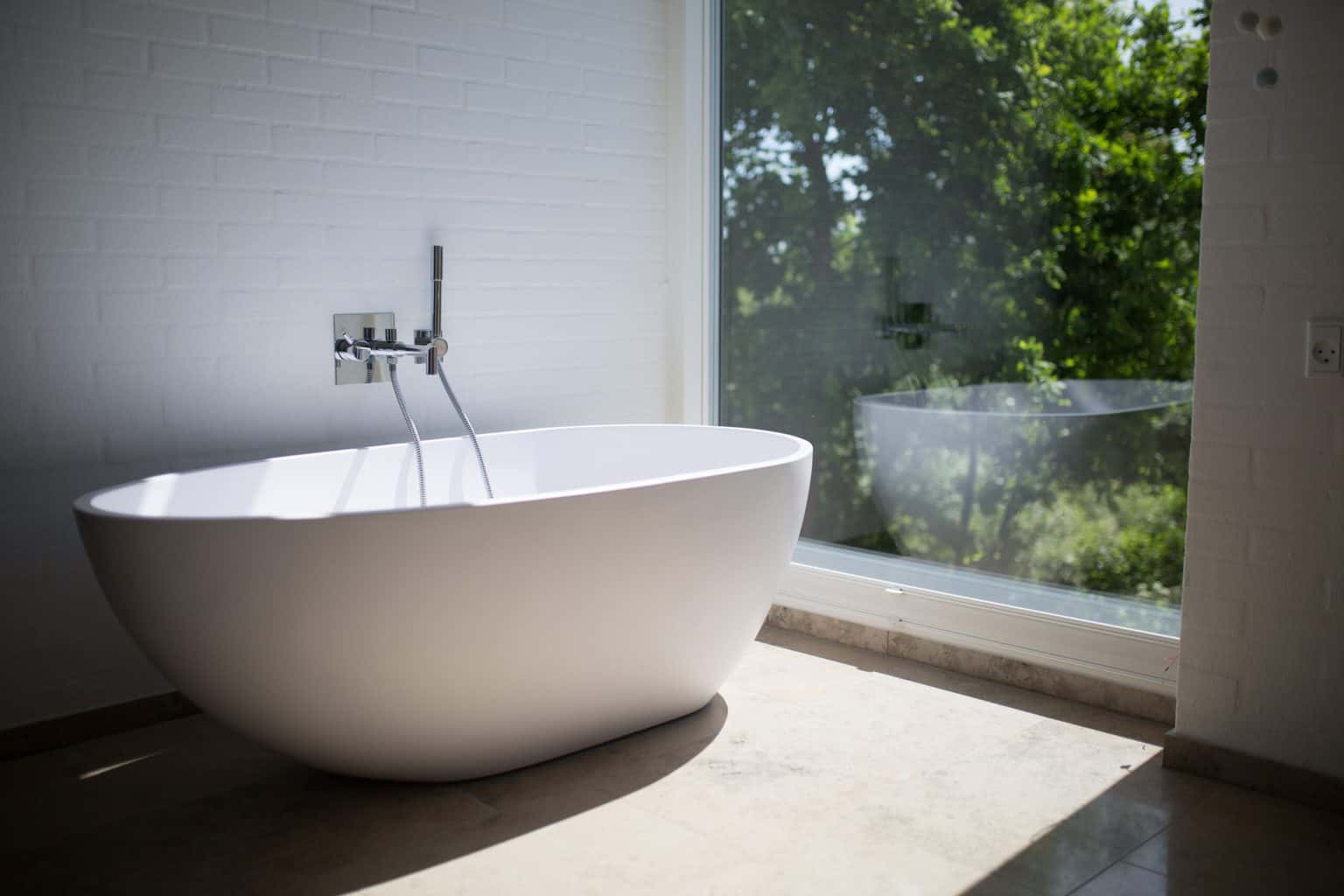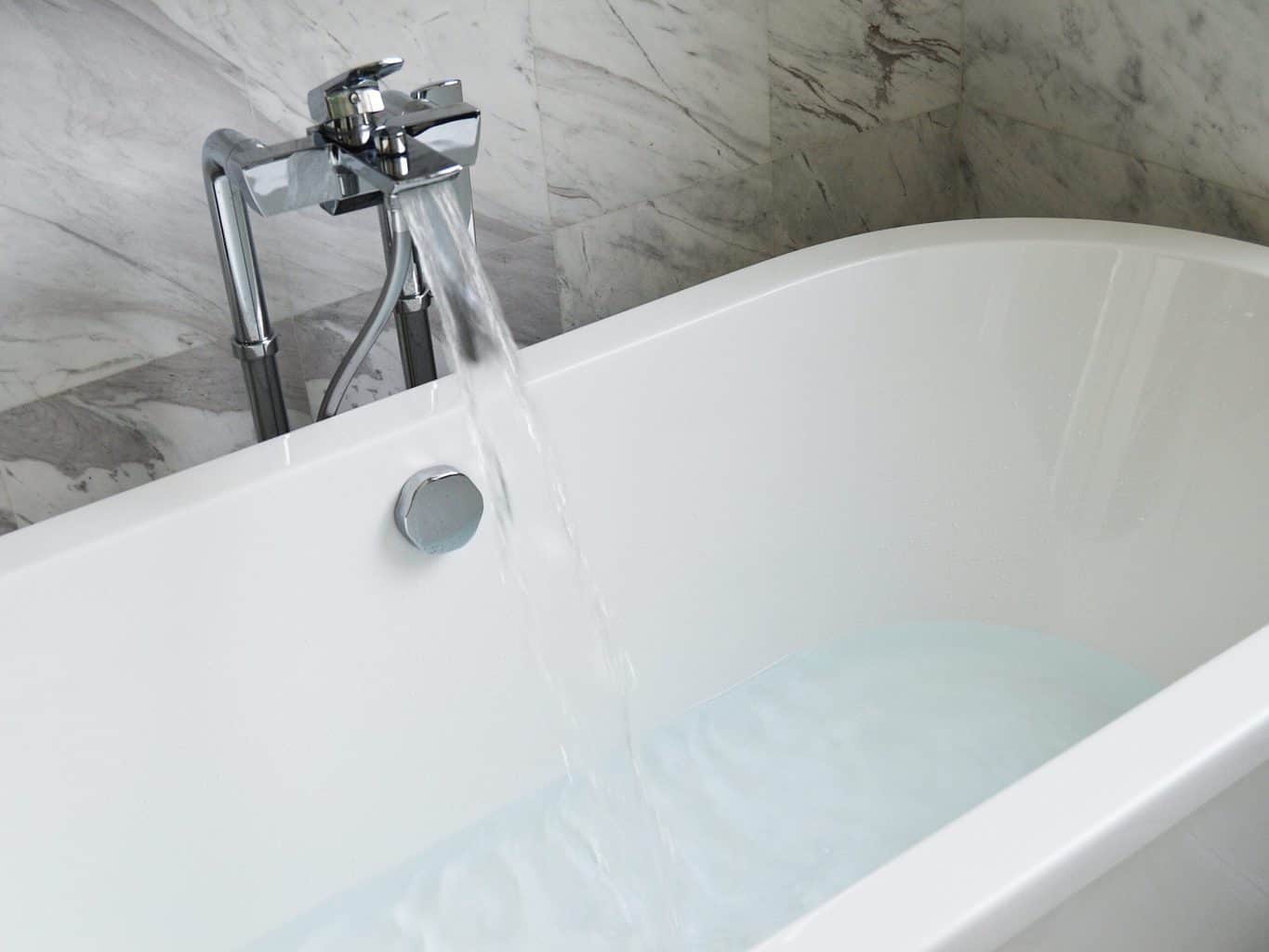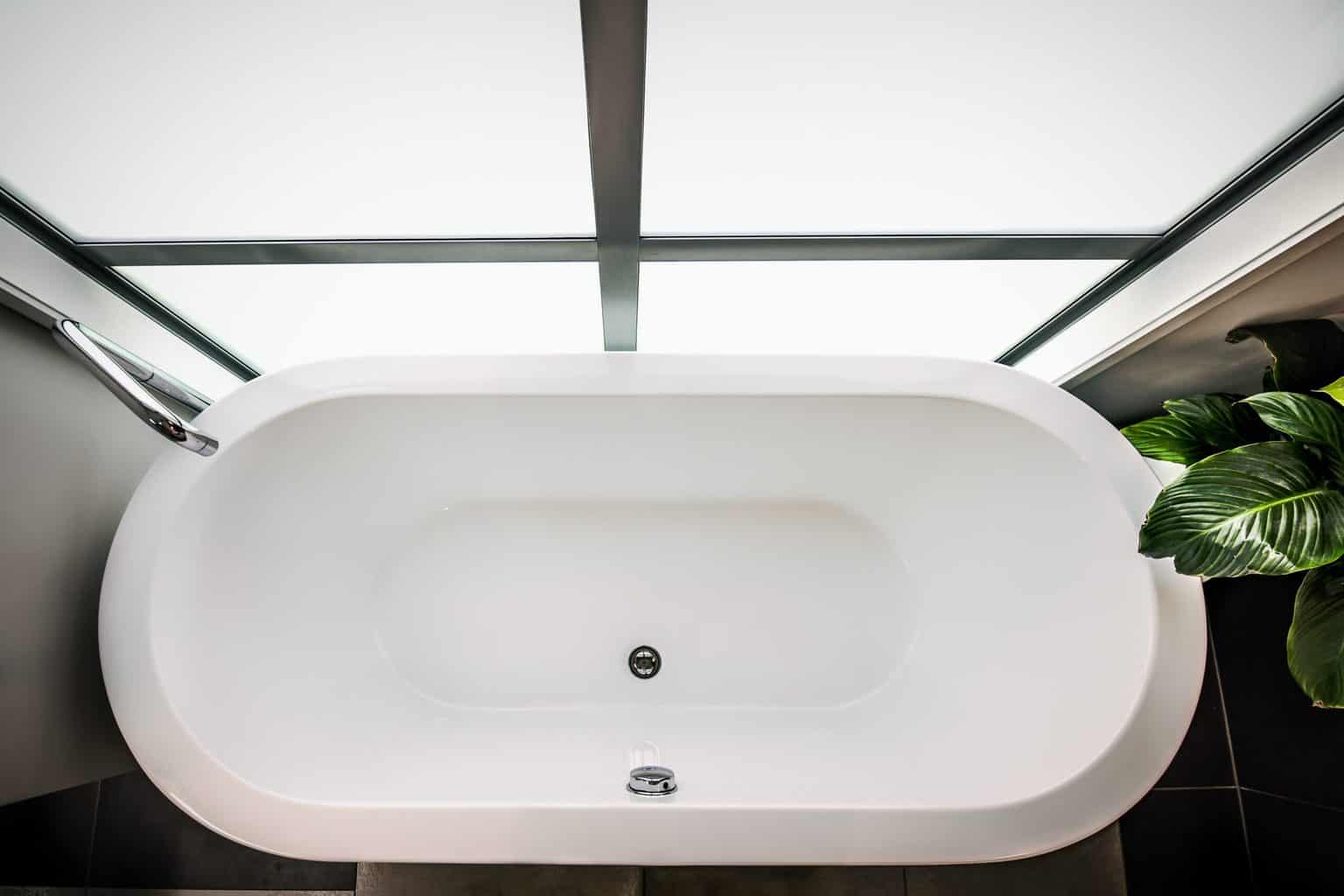As an Amazon Associate we earn from qualifying purchases.
Everyone hates it when something in the bathroom breaks up. It damages the whole experience, and sometimes just prevents you from even taking a bath.
That’s precisely what happens when a bathtub starts to chip away. You may easily hurt yourself while bathing. Sometimes it just looks awful in the bathroom. And if you don’t fix it fast enough, it may end up chipping entirely and/or cracking.
For any of these reasons, you need to learn how to fix a chipped bathtub. Luckily, we’re here to help you out with that.
You’re going to learn everything about fixing chips and refurbishing your chipped bathtub if need be. So, are you ready to start? Then keep scrolling!
Method 1: Fixing Small Chips in Bathtub With Epoxy
The first method is the perfect solution for those small chipped areas that annoy you but are not really that significant. Fixing these chips will help you give a pristine look to the bathtub back.
Materials That We Need For Fixing
- Epoxy repair kit (explained below)
- Water
- Dish detergent / tub cleaner
- Acetone / alcohol (optional)
- Hard-brittle brush
- Spatula or paintbrush
- Sandpaper (220-grit or higher)
What Is an Epoxy Repair Kit?
An epoxy repair kit is like the name says – a tub of epoxy you can use to apply on the chipped area of the bathtub. This type of product works neatly on almost any bathtub material, including porcelain, acrylic, ceramic, enamel, and even fiberglass. Epoxy tolerates surface damage, which means it protects metal from possible corrosion.
You should go for a repair kit with a catalyst and a hardener. This way, you can prepare the epoxy (as much as you need), so you can apply it pristinely on the chipped area. You won’t have to waste any.
Lastly, consider the ideal kit in terms of colors. Epoxies may come in different shades, so it’s wise to look for the right tone if you want proper results.
Cleaning the Chipped Area
- Mix some of the water and detergent. If you prefer acetone and alcohol, then use that.
- Then grab the hard-brittle brush and damp it on the solution.
- Proceed to scrub the chipped area with the brush to get rid of the dirt, grease, soap scum, and so on.
- Let the area dry for a few minutes. Use a rag or cloth if necessary.
Cleaning the chipped area will help you work pristinely and prevent any unwanted results.
Prepare the Epoxy
- Start by following the instructions on the repair kit package.
- If you get an epoxy with hardener and catalyst, then you need to use them in the preparation.
- Look for a tray or small container to mix the epoxy. Use a toothpick or something similar. Some epoxy kits come with their mixing tool. The focus is not to damage other utensils and/or spill the epoxy out.
- You may only need to mix for a minute or two until the mix achieves a specific color.
Once you’ve successfully prepared the epoxy, then you can apply it to the chipped area.
Apply the Epoxy
- Here, you will grab either the spatula or the paintbrush to spread the epoxy on the chipped area.
- Try to apply by spreading towards one side instead of both ways at the same time. This will make the epoxy stick more consistently.
- Don’t add too much epoxy at first. A small scoop will be enough to get the job done. If you apply too much at first, then it may eventually veer off to the sides and spill. And epoxy can be hard to remove once it dries up.
After spreading it well on the chipped area, you’ll need to let it dry.

Let It Dry
- Remember that the epoxy dries up and gets hard. If you don’t let it dry evenly, then it may go to other areas and spread around in the tub. This could be somewhat annoying.
- Most epoxies take between 3 hours to 5 hours to dry up completely. After it dries on the surface, however, you may need to wait up to 24 hours before you can work with it next.
You will know that the epoxy is dry because it feels as hard as the bathtub material itself. Now, you can pick it with your fingers gently or with a small stick. Only test its hardness after at least 5 hours.
Sand and Finish
- First, you will need to get a piece of sandpaper. We recommend pieces over 220-grit, which means something soft enough that doesn’t damage the surface.
- Then you can start sanding. Remember to be utterly careful not to scratch any part outside of the refurbished area.
- Make sure to eliminate any inconsistency in the epoxy. It should look as smooth and neat as possible.
- If the epoxy looks similar to the original bathtub color, then you can leave it like that. Otherwise, you may want to paint it or finish it with the right product.
After sanding, you are done. You’ve successfully fixed a chipped area of a bathtub.
Method 2: Fix Chipped Bathtub Using Refinishing Kit
Let’s say you don’t have a small area of the bathtub chipped. Instead, you may be experiencing a significant area needing to be fixed. In that case, you may want to refinish the whole bathtub instead.
Here’s how:
Gather the Materials:
- Refinishing kit (explained below)
- Primer
- Finishing paint /coating
- Detergent and rag/sponge/brush (optional)
- Sandpaper (400-grit preferably)
- Sanding machine (optional)
- Brush
- Roller
- Paint tray or bowl
- Painter’s tape
What Is a Bathtub Refinishing Kit?
A refinishing kit is a product that comes with every single tool you need to refinish the bathtub material. You may get all the necessary items for this step without having to look for them.
The main product, however, is the resin. You need to make sure it comes with a quality resin coating so you can refinish the tub with it.
In case it is not resin, it can be epoxy. This material also works, but we recommend resin for its appearance, as it looks more like a bathtub material than epoxy.
With the right resin, you can apply it to porcelain, acrylic, ceramic, enamel, and even fiberglass. In case it doesn’t look similar to the bathtub, then you can always sand it and paint it as necessary.
Once you have the ideal refinishing kit, then you can proceed.
Prepare Yourself and the Work Area
- Make sure you have the right gear. We recommend a mask, goggles, and gloves. That will be enough to work with the refinishing it (epoxy/resin).
- Look for newspaper or plastic sheets to cover the entire bathroom from any spill. The epoxy can be hard to take off surfaces once it dries up. So even the smallest drop can make a pretty tough spot to clean away.
- Also, use the painter’s tape to cover fixtures and walls, especially the walls around the bathtub. Try to hide them well enough, so the epoxy/resin doesn’t stick to them later.
- We also recommend getting rid of everything around that you won’t use. From shampoo bottles to soap containers and so on – make sure you can work freely and comfortably.
- Finish the preparation by opening the doors and windows. Epoxy/resin smell can be annoying and cause dizziness, so try to have as much ventilation as possible.
This will help you refinish the bathtub without a single issue. Because you’re working with the entire tub, you will need to be extra careful – so follow these steps to the letter.

Clean the Bathtub
- Here, you can use the bathtub cleaner that comes with the refinishing kit. If it doesn’t come with any, you can use standard detergent and a rag or brush.
- Make sure to clean the entire tub and put special attention to any crevice and/or area that could have extra filth.
- Clean as if you were cleaning anything else. First, rinse the bathtub with water, then apply the detergent or cleaner, and proceed to brush the filth off.
- Let the tub dry for at least 20 minutes before keeping up. You can use a hairdryer or towel as needed.
This will help you prevent any annoying moisture, filth, mold, dirt, scum, etc. from damaging the process.
Sand the Tub
- Try sanding the whole bathtub surface that you want to refinish. We recommend sanding everything so you can refinish it all. This way, the surface won’t look inconsistent after finishing.
- It is usually recommended to use different types of sandpaper grit on the surface. Starting with 220 or 400-grit and slowly getting a higher grit to leave a delicately finished surface. But you can also use a single grit paper and sand it all without problems.
- Sand the surface by moving the sandpaper in a circular motion. Try to be careful not to cause any damage apart from just getting rid of the first coat.
- Finish by getting rid of the dust after sanding. You may use a vacuum, a brush, or a rag. Try to thrash out as much dust as possible from the area.
Sanding will help you get rid of the initial chipped surface as well as cleaning away inconsistencies. After sanding, you’re almost ready to start applying the refinishing product.
Repair Cracked or Chipped Areas
- Start by preparing the epoxy/resin on the refinishing kit. Follow its instructions to the letter.
- Most of the time, it’s all about mixing the catalyst with the hardener with the material. This should take a few minutes to mix entirely until it gets the color of the bathtub (or as close as possible). Use a spatula or stick to blend.
- Once the resin/epoxy material is ready, you can start applying it to the cracked or chipped areas. Use the spatula or paintbrush as you prefer. Spread it well enough on the whole surface where there’s even a small chip/crack.
- After applying it and spreading it evenly on the surface, then you can wait for it to dry. We recommend at least 3 hours up to 5 hours.
- If you feel like smoothing out the surface further, then you can always grab sandpaper to get rid of inconsistencies.
This process will get rid of any crack, chip, or crevice from the surface of the bathtub where the primer and finishing paint can get into. So, it’s an essential step to take.

Apply Primer
- Prepare the primer as necessary. Usually, you just need to stir well enough, so it gets consistent. Follow the instructions on the refinishing kit or primer itself.
- Grab the paintbrush or roller and apply the primer over the whole surface of the bathtub.
- Priming will cover the entire bathtub and make sure it is totally waterproof. At the same time, it flattens out everything and makes it consistent. Then you can easily apply the paint as necessary.
- After applying the primer, you should let it dry for at least 3 hours.
Without the primer, the texture of the bathtub wouldn’t feel like a bathtub.
Apply the Finish
- Prepare the paint as needed. Remember to follow the instructions on the package of the paint itself or the refinishing kit.
- Grab the paintbrush (now clean, of course), and start spreading the paint on the surface. You need to apply at least 2 coats for the surface to be consistent and end up as close to a bathtub as possible.
- We recommend painting in one direction only so you can prevent uneven spots and other unwanted results.
- Also, fill corners and other areas that the paint may be difficult to stick to. Remember to apply at least 3 to 4 coats on these places if the paint or finish product doesn’t stick well at first.
- For each layer or coat, make sure to wait about 30 minutes to let it dry. Then you can apply the next one.
- If you’re using a spray-on finish, then the process may take less time to apply and dry. However, you will need to apply several more coats. We recommend at least 5 layers with spray paint/finish.
This process is the most important one behind the fixing of the chips and cracks. So be extra careful not to make mistakes and to mess up the whole process.
Let It Cure
- Don’t touch or wet the bathtub surface for at least 2 days. You may need to take baths somewhere else if this is your main bathroom.
- If you damage the surface before it cures by either touching it or with moisture, then you’ll experience streaks, bubbles, and cracks. To fix that, you will need to revert the process back again into sanding and refinishing/priming.
- For the best results, when curing, block any access to the bathroom and let it cure alone for as much time as the refinishing kit’s instructions say. Usually, this is for 2 days.
By now, you’ve successfully refinished the whole bathtub by getting rid of those large and ugly chips and cracks.

Bottom Line
As you see, learning how to fix a chipped bathtub is not as hard as it seems. It is like repairing cracks, specifically repairing cracks in ceramic sinks, tub, etc. But it is still a process that may take some effort and time.
For the best results, we recommend following these instructions to the letter and pay attention to even the smallest of details.
Once you’ve finished getting rid of the chips and cracks on the bathtub with either method, you’ll be delighted. So, start fixing those chips today – you won’t regret it.



